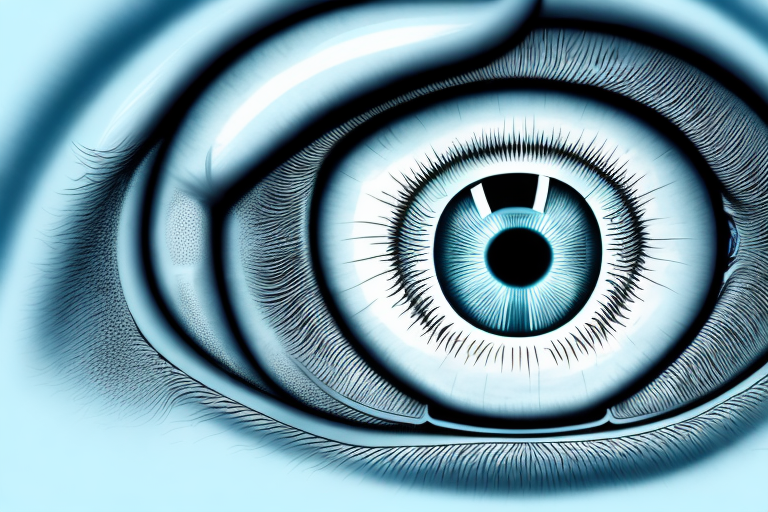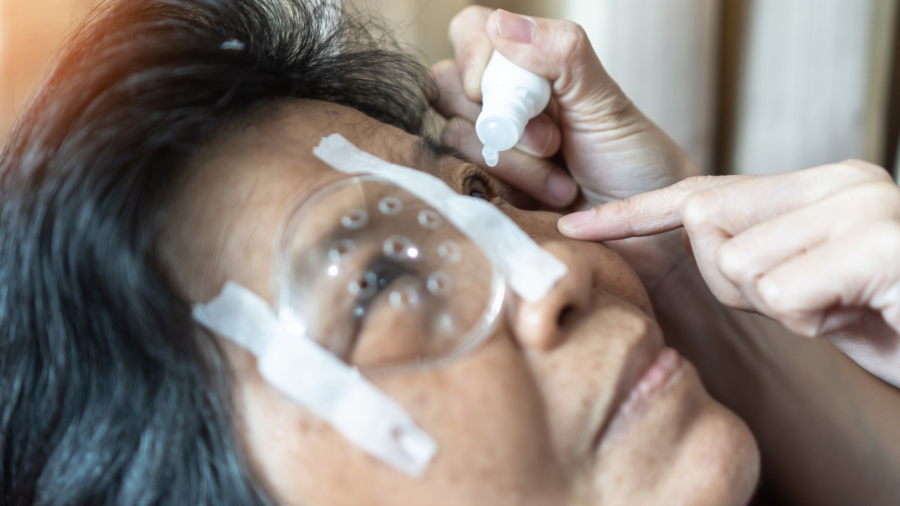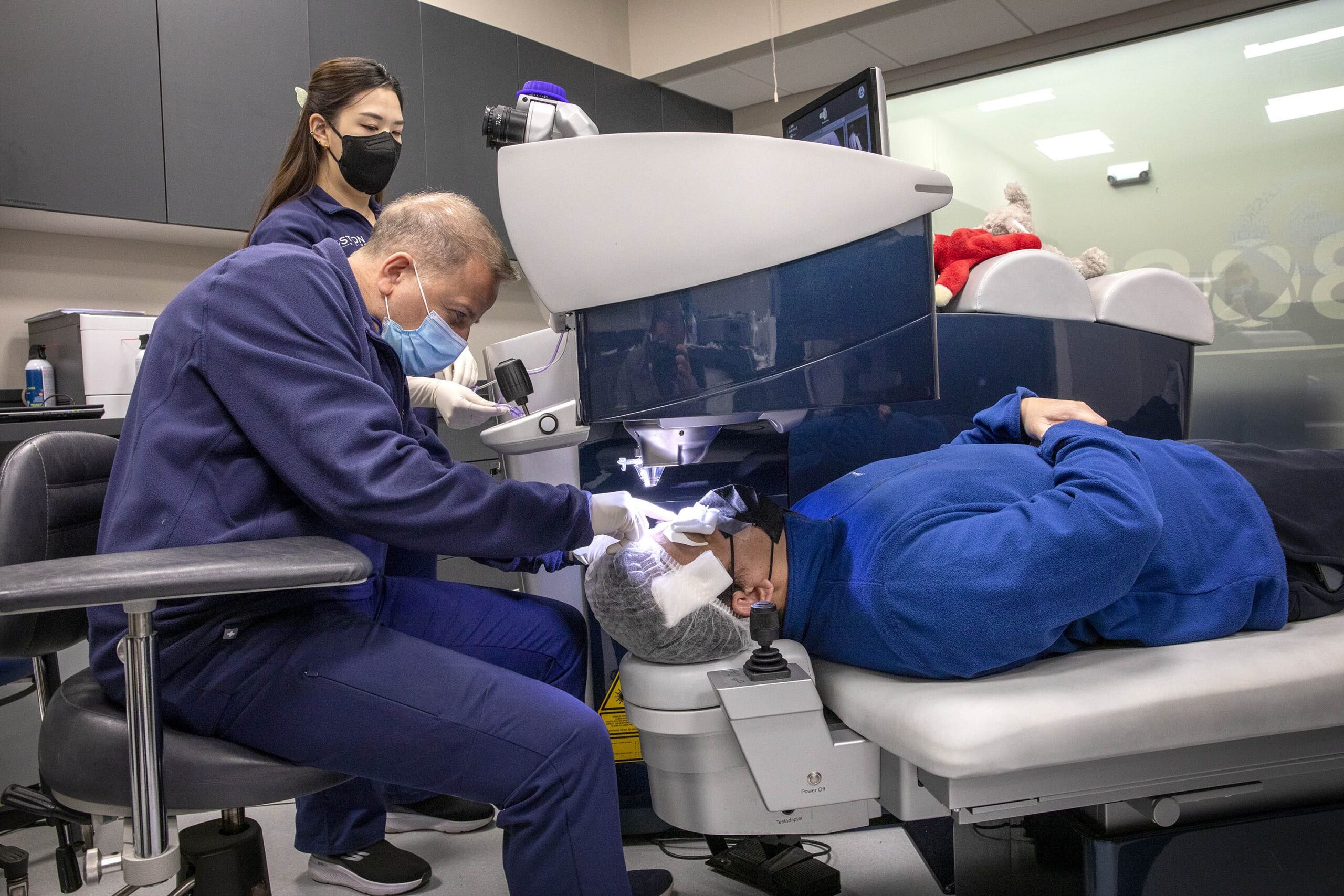In the world of vision correction, LASIK has revolutionized the way people see the world. With its precise laser technology, it offers a safe and effective solution for those wanting to get rid of their glasses or contact lenses. Understanding the science behind LASIK is key to appreciating its benefits.
Understanding the Basics of Vision
Before delving into the intricacies of LASIK, let’s first understand the fundamentals of vision. Our eyes work in harmony to capture light, transmit it to the brain, and process it into the images we see. One of the key players in this process is the cornea.
The cornea is the clear, dome-shaped surface that covers the front of the eye. Its main function is to refract light and focus it onto the retina, which is responsible for converting light into electrical signals that the brain can interpret.

But what exactly happens when light enters the eye? Well, it all starts with the cornea. As light passes through the cornea, it undergoes a process called refraction. This means that the cornea bends the light rays in such a way that they converge onto a single point on the retina. Think of the cornea as a lens, fine-tuning the incoming light to create a clear and focused image. Read more about Post-LASIK Care: What to Do and What to Avoid by clicking here.
Any irregularities in the shape of the cornea can result in vision problems, such as myopia (nearsightedness), hyperopia (farsightedness), or astigmatism. These common refractive errors can be corrected through various methods, including LASIK.
Let’s take a closer look at myopia, for example. Myopia occurs when the cornea is too steep or the eyeball is too long, causing light to focus in front of the retina instead of directly on it. This results in distant objects appearing blurry, while nearby objects remain clear. To correct myopia, LASIK surgery can be performed to reshape the cornea, allowing light to properly focus on the retina and restore clear vision.
On the other hand, hyperopia is the opposite of myopia. In hyperopic eyes, the cornea is too flat or the eyeball is too short, causing light to focus behind the retina. This leads to difficulties in seeing nearby objects clearly, while distant objects may still be in focus. LASIK can also be used to correct hyperopia by reshaping the cornea to improve the focusing power of the eye.
Astigmatism, another common refractive error, occurs when the cornea is irregularly shaped. Instead of being perfectly round like a basketball, the cornea may be shaped more like a football. This causes light to focus on multiple points on the retina, resulting in distorted and blurry vision. LASIK can effectively treat astigmatism by reshaping the cornea into a more symmetrical shape, allowing light to properly converge onto the retina.
Understanding the role of the cornea in vision is crucial in comprehending the benefits of LASIK surgery. By correcting the shape of the cornea, LASIK can help individuals achieve clearer vision and reduce their dependence on glasses or contact lenses. It’s a remarkable procedure that has transformed the lives of millions of people worldwide.
The Evolution of Vision Correction Techniques
Over the years, different approaches have been developed to correct vision problems. Initially, glasses were the primary solution for improving visual acuity, but they had their limitations. Then came contact lenses, offering a more natural way to see without the hindrance of frames.
Glasses, with their ability to correct refractive errors, have been used for centuries. They provided a simple and effective solution for people with nearsightedness, farsightedness, and astigmatism. However, wearing glasses came with its own set of challenges. They could be easily misplaced, broken, or fogged up in certain conditions, making them less than ideal in certain situations.
With advances in technology, contact lenses became thinner, more comfortable to wear, and offered better vision correction. They provided a convenient alternative for those who didn’t want to rely on glasses. Contact lenses allowed wearers to have a wider field of vision, as they moved with the eye, providing a more natural visual experience. They also eliminated the need for constantly adjusting frames or dealing with the discomfort of glasses resting on the nose and ears.
From Glasses to Contact Lenses
Transitioning from glasses to contact lenses was a significant step forward in vision correction. Contact lenses offered a sense of freedom and flexibility that glasses couldn’t provide. People could participate in sports and other physical activities without worrying about their glasses falling off or breaking. Additionally, contact lenses allowed wearers to experiment with different looks, as they didn’t have to rely on a single pair of glasses.
However, contact lenses also had their own set of challenges. They required proper cleaning and maintenance to avoid eye infections and discomfort. Some people experienced dry eyes or allergies when wearing contact lenses, making them unsuitable for long-term use. Additionally, contact lenses were not suitable for everyone, as some individuals had underlying eye conditions that prevented them from wearing them.
The Advent of Surgical Interventions
However, not everyone found contact lenses suitable for their needs. This led to the development of surgical interventions to permanently correct vision. LASIK emerged as a breakthrough procedure, changing the landscape of vision correction.
LASIK, which stands for Laser-Assisted In Situ Keratomileusis, revolutionized the field of vision correction. It involved reshaping the cornea using a laser to correct refractive errors. The procedure was quick, painless, and offered long-lasting results. LASIK allowed people to reduce or eliminate their dependence on glasses or contact lenses, providing them with a new level of visual freedom.
Since the introduction of LASIK, other surgical interventions, such as PRK (Photorefractive Keratectomy) and SMILE (Small Incision Lenticule Extraction), have also gained popularity. These procedures offer alternatives to LASIK, catering to individuals with specific eye conditions or preferences.
It’s important to note that while surgical interventions have shown remarkable success in vision correction, they are not without risks. Potential complications, such as dry eyes, glare, halos, or undercorrections, should be carefully considered and discussed with a qualified eye surgeon before undergoing any procedure.
In conclusion, the evolution of vision correction techniques has come a long way, from the early days of glasses to the introduction of contact lenses and the advent of surgical interventions. Each approach has its own advantages and considerations, allowing individuals to choose the method that best suits their lifestyle and visual needs.
LASIK: A Revolutionary Approach to Vision Correction
LASIK, short for Laser-Assisted In Situ Keratomileusis, introduced a new era in vision correction. It combines the precision of lasers with the reshaping of the cornea to improve visual acuity and reduce the dependence on external aids.
Imagine a world where you wake up every morning with crystal-clear vision, no longer needing to fumble for your glasses or put in contact lenses. LASIK has made this dream a reality for millions of people around the globe.
The Concept of Laser-Assisted In Situ Keratomileusis
LASIK involves creating a thin flap on the cornea, which is then lifted to access the underlying tissue. A laser is used to reshape the cornea, correcting its imperfections and allowing light to focus directly on the retina. The flap is then repositioned, acting as a natural bandage for quick healing.
During the procedure, you may feel a slight pressure on your eye, but rest assured, it is a painless experience. The surgeon uses state-of-the-art technology to ensure precise and accurate corneal reshaping, tailored to your individual needs.
The Unique Advantages of LASIK
LASIK offers several advantages over other vision correction methods. It is a quick and painless procedure that typically results in minimal discomfort and a rapid recovery. Most patients experience significantly improved vision within a day or two after surgery.
Imagine being able to go about your daily activities without the hassle of glasses or contact lenses. LASIK provides the freedom to enjoy sports, travel, and even simple tasks like reading or watching TV without any visual aids.
Moreover, the precision of lasers allows for highly accurate and customized corneal reshaping, addressing each individual’s unique vision requirements. This makes LASIK a reliable and predictable solution for a wide range of refractive errors.
Whether you are nearsighted, farsighted, or have astigmatism, LASIK can help you achieve the clear vision you’ve always desired. The procedure is performed by experienced surgeons who have undergone extensive training to ensure your safety and satisfaction.
It’s important to note that LASIK is not suitable for everyone. Your eye doctor will evaluate your candidacy based on various factors, such as the thickness of your cornea, the stability of your prescription, and the overall health of your eyes.
So, if you’re tired of relying on glasses or contact lenses, consider LASIK as a life-changing option. Join the millions of people who have embraced this revolutionary approach to vision correction and experience the world in a whole new way.
The Science of LASIK Explained
To truly appreciate LASIK, it’s important to dive into the science behind its success. The key factor that sets LASIK apart is the use of lasers.
The Role of Lasers in LASIK
Laser technology plays a crucial role in the LASIK procedure. It allows surgeons to precisely remove microscopic amounts of corneal tissue, tailored to each patient’s specific needs. This accuracy ensures that the cornea is reshaped in a controlled manner, leading to predictable and optimal visual outcomes.
The Precision and Accuracy of LASIK
Lasers provide an unparalleled level of precision and accuracy in the vision correction process. With computer-guided systems, LASIK surgeons can program the laser to perform intricate corneal reshaping with submicron-level accuracy, ensuring excellent vision correction results.
The LASIK Procedure: A Step-by-Step Guide
Now that we understand the science and principles behind LASIK, let’s explore the detailed steps involved in the procedure.
Preoperative Assessments and Preparations
Before undergoing LASIK, patients undergo a series of comprehensive eye examinations to determine their eligibility and address any underlying eye conditions. These assessments involve measuring corneal thickness, mapping corneal curvature, and assessing overall eye health.
Once deemed suitable for LASIK, patients receive detailed preoperative instructions to prepare for the surgery. This may include discontinuing contact lens use, abstaining from certain medications, and maintaining good eye hygiene.
The LASIK Surgery Process
On the day of surgery, patients are made comfortable and given numbing eye drops to ensure a painless experience. The surgeon then creates the corneal flap using a femtosecond laser. This step is followed by the excimer laser reshaping the cornea based on the personalized treatment plan.
During the laser reshaping process, the patient’s eye is closely monitored, and advanced tracking systems ensure precise delivery of the laser energy. Once the corneal reshaping is complete, the flap is gently repositioned, allowing for natural healing and rapid vision improvement.
In conclusion, LASIK represents a remarkable breakthrough in vision correction. With its precise use of lasers, it offers an effective and safe solution for addressing refractive errors. Understanding the science behind LASIK provides valuable insight into the benefits of this life-changing procedure. So, if you’re tired of relying on glasses or contact lenses, LASIK might be the perfect solution to enhance your vision and improve your quality of life.












